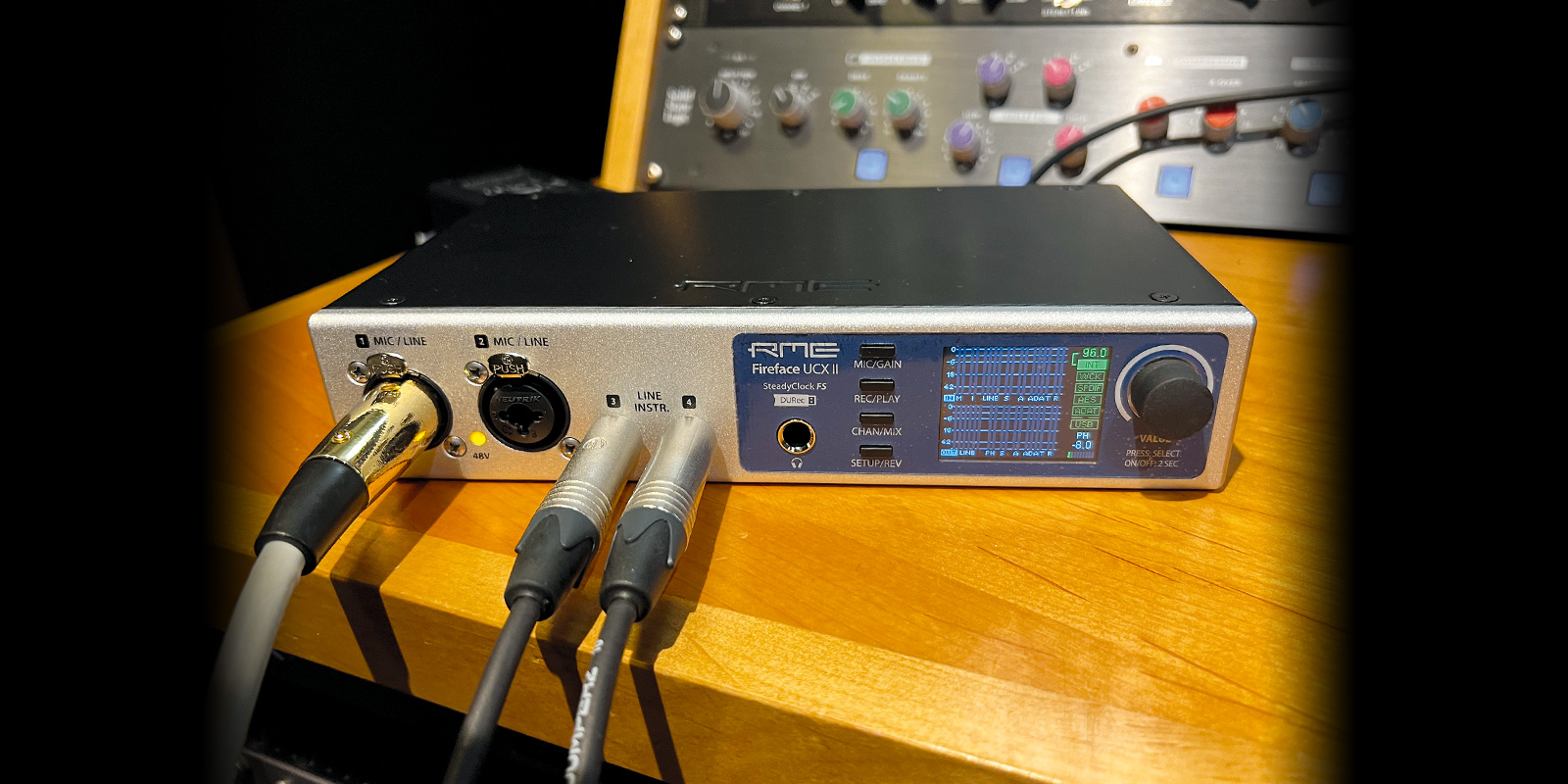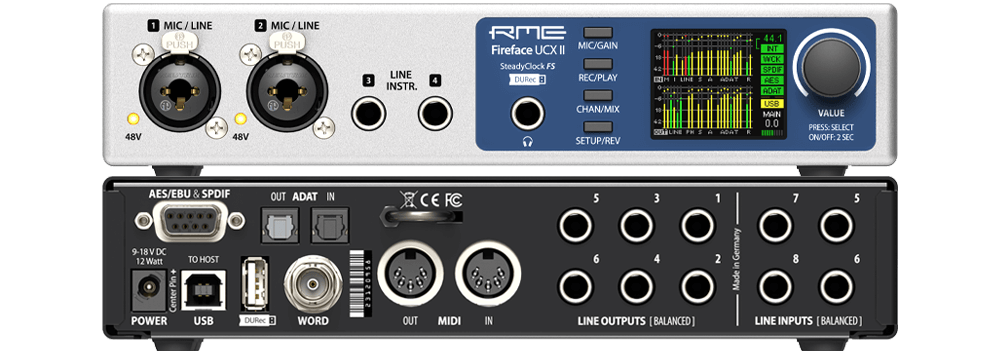A small, mighty and well-connected interface with some cool new tricks up its sleeve
Review by Paul Vnuk Jr.
In 1996 in Haimhausen, Germany, RME started out building PCI-based digital interface cards for a fledgling digital audio industry. Over the following twenty-five years, RME expanded its line to include great-sounding digital audio converters and interfaces and some of the most rock-solid audio drivers in the business. The latest entry is the RME Fireface UCX II, a half rack-sized audio interface that, through a combination of analog and digital wizardry, can accommodate 40 channels of high-fidelity I/O over USB.
The latest face
From Baby to Fire, over the years, RECORDING has reviewed the many faces of RME. Darwin Grosse introduced the original Fireface UCX to readers back in May 2012, calling it a “Greatest Hits collection of RME’s best work.” The new Fireface UCX II retains the size and functionality of the original, updated and expanded with more channels, better sonics, and a snazzy new layout.
Past Featured Reviews
- Review: Chandler TG Microphone Type L
- Focusrite Clarett+ 8 Pre
- Focusrite Scarlett Solo & Scarlett 18i20 / Hitmaker Expansion Bundle
- Review: Focal Alpha 80 Evo
- December 2021: Genelec 8361A
- November 2021: RME Fireface UCX II 40-channel USB Interface
- Focal Alpha 65 Evo
- Hit’n’Mix RipX: DeepAudio
- October 2021: Slate Digital FG-2A and Custom Opto
- September 2021: KRK Classic 7
- Merging Technologies MERGING+ANUBIS Music Mission
- August 2021: Overloud TH-U Premium
On display
The UCX II is housed in an RME-standard half-rack enclosure. Thanks to the addition of a full-color LCD screen, the UCX II has more in common with the RME ADI-2 Pro FS R (reviewed November 2020) than the previous UCX model. Note that the optional ARC USB remote is still available for use with the UCX II.
The display defaults to Peak/RMS metering for every channel, clocking info, and the main output level. A push-button, stepped rotary encoder and four function buttons (Mic/Gain, Record/Play, Channel/Mix, Setup/Reverb) help menu dive and adjust parameters.
With these controls, you can set up the digitally controlled microphone preamps and input channels, control main and headphone output levels, adjust mix routings, determine clock settings, alter the reverb and delay, and more. Most parameters are tweaked with just the rotary encoder, which is a bit iPod-esque, meaning it can be frustrating until you develop some muscle memory. Of course, you can also adjust most UCX II settings in the
excellent RME TotalMix FX software app.
Ins and outs
As with the original model, the front of the UCX II contains a pair of TRS/XLR combo jacks for mic and line in, and two 1/4” TRS line inputs, as well as a 1/4” headphone
output. Four additional balanced 1/4” line inputs are located on the back, along with six balanced 1/4” line outputs. Of special note, the DC-coupled outputs can accommodate CV/gate signals, bridging the gap between many virtual modular synths / DAWs and their CV-equipped hardware counterparts. Along similar lines, the UCX II contains 5-pin MIDI I/O.
On the digital side, there is a pair of ADAT optical ports, BNC word clock I/O, and both stereo AES (XLR) and S/PDIF (phono) on an included multi-pin breakout cable. Adding it all up, this equals 20 input and 20 output channels of total I/O (16 analog/24 digital). Also on the rear of the unit is a standard USB port, a locking 18v DC socket for use with the included external power adaptor, and a USB input port labeled DURec.
DURec
The RME DURec feature is found on the Fireface UFX+, UFX II and UFX audio interfaces. It allows for direct, channel-for-channel (20 in the case of the UCX II)
standalone multitrack recording to a FAT32-formatted thumb drive or external hard drive (up to 2TB). This feature is pretty slick and turns the UCX II into a very attractive remote recording device where you can leave your computer at home. RME does use an interleaved Broadcast WAV file format where each wave file is split into a successive file after a 2gig limit is reached. Still, all the files are easily and quickly reconstructed with the free RME Multi-Channel Batch Processor, allowing them to be imported, edited and mixed in your favorite DAW.
Steady as she goes
The UCX II can handle digital audio rates up to 24-bit/192 kHz. One of the more significant upgrades of the UCX II is the implementation of the RME SteadyClock FS technology. We were introduced to this technology in Justin Perkins’ aforementioned November 2021 RME ADI-2 Pro FS R review and again in my review of the ADI-2 DAC FS in March of this year.
The RME SteadyClock FS technology ensures perfect jitter reduction and stable clocking both when clocked internally or externally. This technology achieves jitter reduction to levels that can be measured in femtoseconds. RME loves to point out that this is 1/1,000,000,000,000,000 of a second!
Totally
One final feature of the unit is its internal DSP and the well-loved RME TotalMix FX software. We have covered both extensively in past reviews, but as a quick recap, the TotalMix FX software (Mac and PC compatible) was one of the very first software-controlled DSP-based mixing apps ever. It offers latency-free, hardware mixer-style routing and control over every available channel in the UCX II. This includes control over preamp settings, including +48v phantom power and levels, DSP-based filters, EQ and dynamics available on every channel, and internal reverb and effects. It is possible to use this processing during tracking and mixing thanks to internal loopback functions, but that’s a tutorial beyond the scope of this review; RME has a stellar TotalMix FX Beginner’s Guide Tutorial Series on its home page.
Sound and use
The UCX II is a great-sounding, powerful audio interface for both studio and remote recording tasks. The two onboard preamps trend toward the transparent and neutral side of the scale and hold their own with many similar standalone models. The digital conversion is equally clean and transparent, and it is painless to add a favorite ADAT-equipped eight-channel preamp or expansion box and/or a stereo digital device or two, perhaps even digital-equipped monitor speakers.
Wrap-up
Bottom line, the UCX II is an expandable powerhouse of a unit with a surprisingly small footprint. Often when I hear about and review eight-channel analog interfaces like this that profess higher channel counts, I am skeptical that these channel counts are anything more than market speak, meaning most of us will rarely utilize them. Yet, on the UCX II, it all makes sense and comes together in a great-sounding, easy-to-use, and highly versatile audio interface that includes standalone multitrack recording.
From all of us at RECORDING, Happy 25th Anniversary, RME!
Price: $1499
More from: rme-usa.com



